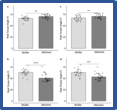Peak Torque Comparison between SMM iMoment and Biodex System Pro 4 Isokinetic Dynamometers
Primerjava največjega navora med izokinetičnima dinamometroma SMM iMoment in Biodex System Pro 4
DOI:
https://doi.org/10.18690/actabiomed.204Keywords:
inter-machine reliability, knee flexors, angle of peak torque, peak torqueAbstract
Purpose: To compare peak torque of knee extensors and flexors during muscle contractions between the SMM iMoment and Biodex System Pro 4 isokinetic dynamometers (inter-machine reliability).
Methods: Twenty-five students (14 men and 11 women, age 24.35 (1.41) years) took part in a crossover study. Peak torque (PT) and angle of peak torque (APT) for knee extensors and flexors were assessed at the velocity of 60°/s and 180°/s on two visits. Paired t-test, intraclass correlation coefficient (ICC), standard error of measurement (SEM), coefficient of variation (CVmed) and Bland-Altman plots were used to determine significant differences, relative and absolute reliability and agreement between devices.
Results: There were statistically significant differences in PT between machines at the velocity of 60°/s for the right leg knee flexion (p = 0.027). ICC values revealed high to very high relative reliability for the left leg (0.84 - 0.93) and moderate to very high for the right leg (0.79 - 0.91). Values of absolute reliability revealed more substantial differences between dynamometers compared to other similar studies (CVmed: 4.84% - 9.36%, SEM: 9.62 Nm - 26.11 Nm). Bland-Altman plots revealed no specific bias in exercise performed with the left leg and small bias (4-6 Nm) in exercises performed with the right leg. There were significant differences in APT between dynamometers in all conditions.
Conclusion: Mean peak torque values of knee extensors and flexors were similar between machines; however, data collected using the iMoment dynamometer were substantially more variable.
Downloads

Downloads
Published
Issue
Section
License
Copyright (c) 2020 Acta Medico-Biotechnica

This work is licensed under a Creative Commons Attribution 4.0 International License.